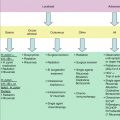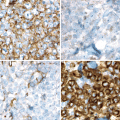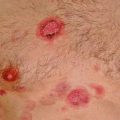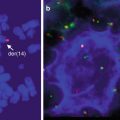Fig. 11.1
A rare case of primary CNS lymphoplasmacytic lymphoma demonstrating a perivascular lymphoid infiltrate (10×) composed of lymphoplasmacytic cells (400×)
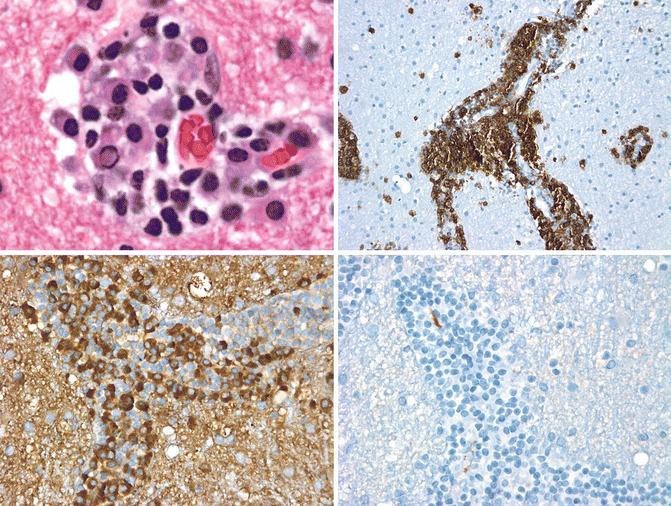
Fig. 11.2
Lymphoplasmacytic lymphoma from Fig. 11.1 showing the presence of a Dutcher body (upper left). The lymphomas expressed CD20 (upper right, 400×). Kappa (lower left) and lambda (right) light-chain staining showed kappa restriction (400×)

Fig. 11.3
A rare case of mucosa-associated lymphoid tissue (MALT)-type lymphoma arising from the ventricular choroid plexus (upper left quadrant) (20×). The inset (400×) shows the cytologic feature of the lymphomas, which was CD20+, CD5−, CD10−, and monoclonal
In PCNSL, many biopsies are now stereotactic biopsies and thus only a small amount of tissue is available for diagnosis. Although architecture is therefore limited, most cases will show a diffuse growth pattern consisting of intermediate-to-large cells with vesicular chromatin. A centroblastic appearance is most common with an immunoblastic appearance being seen in less than 10 % of cases (Preusser et al. 2010). Immunoblastic morphology is more frequently seen in the setting of HIV infection. Rare cases may demonstrate plasmablastic features (Urrego et al. 2011). Necrosis is often present and when vessels are represented, a propensity for tumor cells to be present in a perivascular location can be seen (Fig. 11.4) (Preusser et al. 2010).


Fig. 11.4
PCNSL with the histology of diffuse large B-cell lymphoma showing a perivascular distribution (400×) and CD20 expression (inset, 400×)
Secondary CNS involvement is extremely rare in indolent lymphomas. It is observed in up to 6 % of aggressive non-Hodgkin’s lymphomas and is more frequent in Burkitt lymphoma and lymphoblastic lymphoma (Herrlinger et al. 2009).
11.1.1 Immunophenotype
PCNS DLBCL expresses pan-B-cell antigens such as CD19 and CD20 as well as monotypic surface immunoglobulin light chains. CD10 is expressed in only a minority (<10 %) of cases, BCL6 in 60–80 %, and IRF4/MUM1 in 90 % (Preusser et al. 2010). Thus, a non-germinal B-cell phenotype is diagnosed in most cases (Fig. 11.5) (Preusser et al. 2010; Hattab et al. 2010; Hans et al. 2004). HLA molecules are often absent and likely related to genetic loss of the HLA locus at chromosome 6p21.3 (Booman et al. 2006; Riemersma et al. 2000). BCL6 expression has been found to be of prognostic relevance (favorable) in more than one study (Preusser et al. 2010; Braaten et al. 2003; Levy et al. 2008; Lin et al. 2006; Song et al. 2011), but others have found the opposite in the setting of high-dose methotrexate (HDMTX) and radiation (Momota et al. 2010).


Fig. 11.5
PCNS diffuse large B-cell lymphoma with a non-germinal center B-cell immunophenotype. The hematoxylin and eosin stain shows a diffuse sheet of large lymphoid cells with prominent nucleoli that replaces the normal brain parenchyma (400×, upper left). The cells were positive for CD20 (upper right, 400×) and negative for CD10 (not shown) but expressed BCL6 (lower left, 400×) and MUM1 (lower right) and would be classified as non-germinal center B-cell phenotype according to the Hans classifier (Cady et al. 2008)
11.1.2 Genetics
Relatively little is known about the molecular genetics of PCNSL DLBCL, due to its rarity and lack of adequate tissue for such studies. Montesinos-Rongen et al. demonstrated that these tumors often show somatic hypermutation of the rearranged immunoglobulin genes and preferential use of the VH4-34 gene segment (Montesinos-Rongen et al. 1999). Del(6q)(q22) and BCL6 translocation (usually partnered with IGH@) were reported in 45 and 17 % of cases, respectively, and appear to be associated with inferior survival in the setting of HDMTX therapy, whereas MYC translocations were found in 3 % of cases (Cady et al. 2008). EBV is usually absent in immunocompetent patients but is often present in cases involving immunocompromised patients (Preusser et al. 2010; Cavaliere et al. 2010; Knowles 2003). Gene expression studies have reported high-level expression of regulators of the unfolded protein response signaling pathway, MYC, and PIM1 and have identified a potential role for IL-4/STAT6 signaling (Rubenstein et al. 2006). Pathway analysis revealed that PCNSL, as compared to non-CNS DLBCL, is characterized by differential expression of multiple extracellular matrix (ECM) and adhesion-related pathways. The most significantly upregulated gene was the ECM-related osteopontin (SPP1) (Tun et al. 2008). Differential expression of microRNAs (mRNAs) has been found between nodal and CNS DLBL (Fischer et al. 2011a). MiRNAs associated with the MYC pathway (miR-17-5p, miR-20a, miR-9), with blocking of terminal B-cell differentiation (miR-9, miR-30b/c), or with upregulation by inflammatory cytokines (miR-155) were upregulated in PCNSL, whereas the potential tumor suppressor MiRNAs such as miR-199a, miR-214, miR-193b, and miR-145 were downregulated. Prompted by findings in nodal DLBCL related to potential activation of the NFκB pathway, activating mutations in CARD11 and inactivating mutation of TNFAIP3 have been studied, and mutations in the former have been found in approximately 10 % of cases while mutations in the latter are uncommon (Montesinos-Rongen et al. 2010; Rubenstein et al. 2013).
11.2 Differential Diagnosis
The differential diagnosis of CNSL includes inflammatory conditions such as sarcoidosis, cerebral vasculitis, or multiple sclerosis plaques but also infections such as tuberculoma or toxoplasmosis, particularly in immunosuppressed patients. Rare cases of DLBCL may present with lymphoma cells entirely within vessels, and these cases are best classified as intravascular large B-cell lymphoma. This uncommon variant of extranodal large B-cell lymphomas may occur in the CNS (Yegappan et al. 2001). Non-hematopoietic round cell neoplasms such as primitive neuroectodermal tumors, poorly differentiated or neuroendocrine carcinomas, melanoma, and primary brain tumors such as oligodendrogliomas can mimic lymphomas but are easily distinguished with immunohistochemistry. These tumors will all lack pan B-cell markers such as CD20 and CD79a.
11.3 Pathogenesis
A proposed mechanism for CNS tropism of the malignant B cell in PCNSL is one in which a clone of malignant B cells is selected via the upregulation of specific adhesion molecule(s) that facilitate homing to the CNS, and secondarily, the tumor cells proliferate and undergo secondary mutations in the absence of regulatory control by the immune system. In support of this is the demonstration that subclinical tumor-related clones are detectable in the blood and bone marrow of PCNSL patients, suggesting that the CNS microenvironment might promote a more aggressive phenotype (McCann et al. 2009; Jahnke et al. 2006b). However, to date, no differences in the expression of adhesion molecules have been identified between PCNSL and systemic lymphomas. Recently, CXCL13 (BCA-1), a B-cell-attracting chemokine, was determined to be expressed at significant levels in PCNSL tumors. Notably, CXCL13 is expressed in Helicobacter pylori-induced mucosa-associated lymphoid tissue as well as in gastric lymphoma (Mazzucchelli et al. 1999). Similarly, expression of the chemokine stromal-derived factor-1 (SDF-1) has also been demonstrated by malignant B cells in PCNSL. Ectopic expression of these chemokines within the intraocular compartment and brain may contribute to lymphoma cell homing to the retina and CNS microenvironments (Smith et al. 2007; Fischer et al. 2009a).
11.4 Risk Factors
11.4.1 Risk Factors for PCNSL
Immunodeficiency is the only identified risk factor for development of PCNSL. However, PCNSL became very rare in HIV-infected persons since the introduction of HAART, reflecting the important role of immune system in the development of this disease.
11.4.2 Risk Factors for SCNSL
There is still a concern about the definition of risk group for CNS relapse in systemic lymphoma, since no study has been able to properly address this question. The existing risk models are based on clinical characteristics and have a low specificity and sensitivity implying a potential overtreatment in up to 70 % of patients deemed at high risk.
Current practice for prophylaxis varies widely, with involvement of particular sites such as paranasal sinuses, testes, orbital cavity, and bone marrow triggering prophylaxis at most centers. In the largest series of 1,693 elderly patients, a 6-year probability of CNS relapse tenfold higher was found for patients with testicular, orbit, and paranasal sinuses involvement as compared to other patients. Patients with testicular involvement had a 6-year probability of CNS relapse of 22.1 vs. 2.1 % in patients without testicular involvement (p < 0.001). The probability of CNS failure at 6 years for patients with or without orbit and paranasal sinuses involvement was 33 % vs. 2 % (p = 0.02) and 26 % vs. 2 % (p > 0.001), respectively (Boehme et al. 2007).
Recently, a risk model was proposed based on an analysis of 1,222 elderly patients with DLBCL treated with CHOP without or with rituximab (R-CHOP). The group with involvement of more than one extranodal site, elevated LDH, and low ECOG performance status (4.8 % of patients treated with R-CHOP) showed a probability for CNS events at 2 years of 33.5 % as compared with 2.8 % in other patients given R-CHOP (Boehme et al. 2009).
New approaches to identify patients with systemic lymphoma at risk who should receive CNS prophylaxis are needed.
11.5 Clinical Presentation and Diagnostic Procedures
11.5.1 Symptoms of CNS Lymphoma
PCNSL most frequently presents with cognitive dysfunction, psychomotor slowing, disorientation and neurological focal symptoms, whereas cranial nerve palsies, seizures, cerebellar symptoms, and symptoms of elevated intracranial pressure are less frequent (<20 %). In patients with ocular involvement (see below), blurred vision and floaters are the most common symptoms.
SCNSL occurs after a median time of 6 months after first lymphoma diagnosis (Herrlinger et al. 2009). It may present as brain parenchyma lesions (approx. 40–80 %) with symptoms similar to those in PCNSL or as meningeal involvement. In most recent publications, 20–40 % of patients had simultaneous systemic disease (Boehme et al. 2007; Schmitz et al. 2012; Villa et al. 2010).
11.5.2 Diagnostic Procedures
Cranial MRI with contrast enhancement is the method of choice for further diagnostics and usually shows intense and homogenously enhancing lesions without necrosis and with a relatively small edema, typically localized in the periventricular space (Küker et al. 2005) (Fig. 11.6). PCNSL most often presents as a solitary lesion, but multiple lesions may be detected in up to a third of the patients. Sometimes, contrast enhancement of the meninges indicating meningeal involvement can be seen (Fig. 11.6).
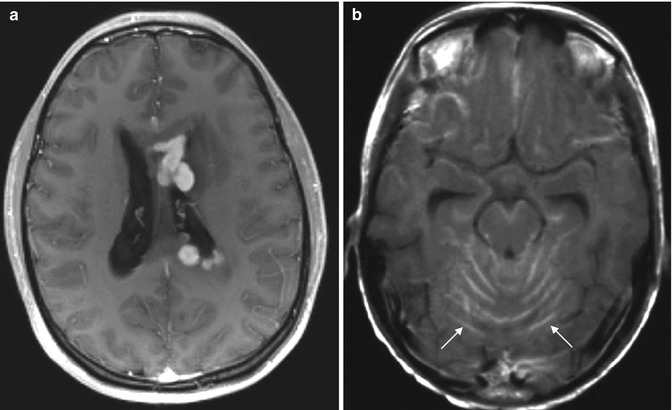

Fig. 11.6
PCNSL on MRI. (a) Parenchymatous lesion with a typical localization in the periventricular space, intense and homogenous contrast enhancement, and a relatively small edema and (b) contrast enhancement of the meninges indicating meningeal involvement
Diagnostic evaluation focusses on the establishment of the baseline extent of the disease and the exclusion of systemic lymphoma. According to the International PCNSL Collaborative Group (IPCG) (Abrey et al. 2005), staging examinations should include physical examination with palpation for enlarged lymph nodes as well as testicular examination in males; computed tomography of the neck, chest, abdomen, and pelvis; and bone marrow biopsy. Also, blood tests for HIV, complete blood cell count, basic metabolic profile, and lactate dehydrogenase level are recommended. Testicular ultrasonography should be considered in elderly males. Additionally, ophthalmologic examination and lumbar puncture (for cell count, protein and glucose measurement, cytology, and, facultatively, for flow cytometry studies and immunoglobulin heavy-chain gene rearrangement) should be performed.
Making the diagnosis from the CSF is usually not possible since meningeal involvement can be found only in a minority of patients. Even using PCR for immunoglobulin heavy-chain gene rearrangement in addition to conventional CSF cytomorphology and MRI concurrent leptomeningeal involvement was seen in about 15 % of patients (Korfel et al. 2012) (Fig. 11.7). In systemic lymphoma, flow cytometry was reported to increase the diagnostic yield of cytologic examination of CSF alone from approximately 13 to 23 % (Schroers et al. 2010a; Collie and Hsi 2013). In the future, CSF multicolor flow cytometry as well as new CSF parameters such as free immunoglobulin light chains, miRNAs, or CXCL13 may become useful tools as noninvasive biomarker for the diagnosis of CNSL (Schroers et al. 2010b; Sancho et al. 2010; Baraniskin et al. 2011; Fischer et al. 2009b).


Fig. 11.7
Malignant lymphocytes in CSF
In the setting of HIV infection, examination of the CSF for EBV has been used to aid in the diagnosis of PCNSL in patients with suggestive radiographic findings without tissue biopsy (Ambinder et al. 2010; Cinque et al. 1993; De Luca et al. 1995).
Ocular involvement (retina, optic nerve, vitreous) is diagnosed in approx. 15 % of patients (Fig. 11.8) and may develop before, concurrent with, and after brain parenchyma manifestations. Typical clinical findings include vitreous cellular infiltration (lymphoma and inflammatory cells) and subretinal tumor cell infiltrates. Elevation of IL-10 levels in the ocular fluid and/or an IL-10:IL-6 ratio >1 is highly suggestive of ocular lymphoma; however, for diagnosis confirmation, vitrectomy or, at specialized centers, chorioretinal biopsy usually is required (Chan et al. 2011).
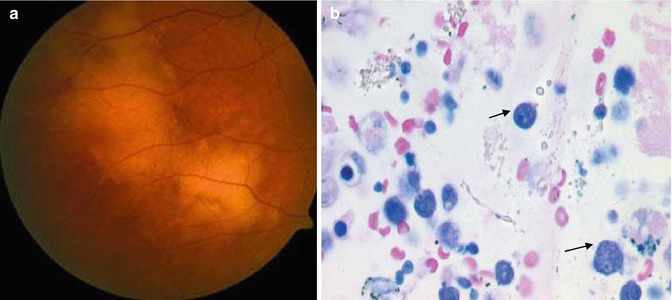

Fig. 11.8
Primary intraocular lymphoma: (a) subretinal infiltrates and (b) lymphoma cells in the vitreous
Diagnosis of PCNSL is usually established by stereotactic biopsy from a CNS lesion. Making the diagnosis can be significantly hampered by pretreatment with glucocorticoids; thus, they should be avoided prior to surgery whenever possible.
In systemic lymphoma, a search for CNS involvement should be considered in patients with more than one extranodal site, elevated serum LDH, and ECOG performance status >2.
11.6 Treatment
11.6.1 Treatment of PCNSL
11.6.1.1 Role of Surgery
Surgery alone is not a viable treatment option due the infiltrative nature of lymphoma and its multifocality. The current approach is to abandon tumor resection excepted for patients with uncontrollable neurological deterioration due to brain herniation. The role of surgery is currently limited to stereotactic guided biopsy for diagnosis establishment. However, data from the first randomized phase III trial (G-PCNSL-SG1) trial have challenged this view (Weller et al. 2012).
11.6.1.2 Role of Radiotherapy
Whole-brain radiotherapy (WBRT) produces complete remission (CR) in up to 90 % of patients, however, usually with a poor long-term disease control and median overall survival (OS) of only 12–16 months and a 5-year OS of 10–29 % (Nelson et al. 1992; Laperriere et al. 1997). In the latest 1990s, the combination of HDMTX-based chemotherapy followed by WBRT was established as standard therapy for PCNSL with CR rates between 69 and 87 % and median progression-free survival (PFS) of 24–40 months in phase II studies (Abrey et al. 2000; O’Brien et al. 2006; DeAngelis et al. 2002; Poortmans et al. 2003; Ferreri et al. 2006). Unfortunately, these improved long-term results were overshadowed by severe neurological impairment including dementia and death, particularly in older patients (Abrey et al. 1998; Gavrilovic et al. 2006). This led to the investigation of WBRT dose reduction or even radiotherapy withdrawal in patients with a CR after chemotherapy alone. It took until 2010 that a randomized phase III trial investigating the role of WBRT in the primary treatment of PCNSL was published. Here, no significant difference in OS (primary end point) was found when WBRT (45 Gy in 1.5 Gy fractions) was omitted from primary therapy (after HDMTX-based chemotherapy): OS in the per protocol population was 32.4 months with and 37.1 months without WBRT (p = 0.7; Fig. 11.9) (Thiel et al. 2010). However, a benefit for PFS was found (18.3 vs. 11.9 month, respectively, p = 0.13), which proved significant in subgroup analyses suggesting an important role of WBRT for disease control. This study has been criticized for the upfront randomization and the high number of protocol violations. Nevertheless, with a median patient age of 63 years, 24 % of patients >70 years, and 15 % of patients with KPS ≤ 40 %, this trial truly represented the “reality” of PCNSL management in the clinical routine. The results of this trial indicate that WBRT can be deleted from primary therapy of PCNSL.
11.6.1.3 Chemotherapy
Chemotherapy should be considered first-line treatment for all PCNSL patients able to receive it. Drugs for PCNSL treatment need to cross the blood–brain barrier (BBB) which is supported by the observation that WBRT + CHOP (cyclophosphamide, vincristine, doxorubicin prednisolone) regimen has proved no better than WBRT alone (Mead et al. 2000). HDMTX (>3 g/m2) is the most important drug for treatment of PCNSL. With a short-time infusion (3–4 h), the majority of patients achieve cytotoxic levels in the CSF (Borsi and Moe 1987; Shapiro et al. 1975). In nonrandomized studies using chemotherapy alone, results comparable to those achieved with chemotherapy followed by WBRT were reported (Herrlinger et al. 2005; Batchelor et al. 2003; Hoang-Xuan et al. 2003; Pels et al. 2003; Juergens et al. 2010; Chamberlain and Johnston 2010). Higher response rates and probably longer disease control can be achieved when HDMTX is combined with other drugs. In the only randomized phase II trial with 79 patients comparing HDMTX monotherapy (3.5 g/m2 every 3 weeks) to HDMTX+ high-dose cytarabine (HDAraC), a significantly improved outcome was observed with the combination with CR rate of 46 % vs. 18 % (p = 0.006) and 3-year OS of 46 % vs. 32 % (p = 0.07), respectively (Ferreri et al. 2009). Hematologic toxicity was higher in the combination arm. The problem with this study was the underdose in the monotherapy arm resulting in a very poor outcome.
In the G-PCNSL-SG1 trial, the addition of ifosfamide (1.5 g/m2 over 3 days) to HDMTX introduced per amendment during the course of the study resulted in significantly improved CR rate of 42 % vs. 32 % and primary progression rate reduction of 15 % vs. 26 %. Not surprisingly, toxicity was higher with the combination, particularly in elderly patients (Thiel et al. 2010).
The best long-term results in PCNSL were reported with an intensive chemotherapy-only regimen including HDMTX (5 g/m2), HDAra-C (3 g/m2), vincristine, alkylating agents, and dexamethasone combined with intensive intraventricular chemotherapy (Pels et al. 2003). Median event-free survival (EFS) was 21 months and OS 50 months. A recent follow-up showed that 57 % of patients <60 years were alive after a median follow-up of 100 months without evidence of chemotherapy-related neurotoxicity (Juergens et al. 2010).
Intra-arterial infusion of MTX-based chemotherapy following osmotic blood–brain barrier disruption aiming at delivering higher drug concentrations to the tumor has been assessed by several groups. In the most recent multi-institutional analysis, the results were comparable or even better than with many conventional treatments with a 5-year PFS of 31 % and 7-year PFS of 25 %. However, the procedure can be associated with some acute toxicity and is presently available at specialized centers only (Angelov et al. 2009).
The role of the anti-CD20 monoclonal antibody rituximab in PCNSL is not defined. As a large protein, it has poor penetration into the CNS as measured by CSF levels (Rubenstein et al. 2003). The combination of rituximab and HDMTX-based chemotherapy proved feasible and active in small studies (Chamberlain and Johnston 2010; Shah et al. 2007; Wieduwilt et al. 2012); however, one study (Shah et al. 2007) suggested increased hematologic toxicity of the combination.
11.6.1.4 Salvage Therapy
Salvage treatment should be chosen based on patient’s age, performance status, prior therapy, and duration of previous response. WBRT is a very effective salvage treatment with a response rate of >60 % and a median OS after relapse of 16 months, but with increased risk of neurotoxicity (Nguyen et al. 2003; Hottinger et al. 2007). Thus, delaying WBRT whenever possible and offering chemotherapy to patients with recurrent disease seems a reasonable option, particularly in those with good performance status and response to previous chemotherapy. Patients with a long-term remission after HDMTX can be rechallenged with a good chance for a second long-term remission (Plotkin et al. 2004). In several small studies, responses and sometimes long-term control were reported for temozolomide alone or with rituximab (Reni et al. 2007; Enting et al. 2004), topotecan (Fischer et al. 2006), and ifosfamide- or etoposide-based combination chemotherapy.
Promising results at relapse were reported with high-dose chemotherapy followed by autologous stem-cell transplantation (ASCT). A regimen of thiotepa, busulfan, and cyclophosphamide followed by ASCT produced a 2-year OS of 45 % in 43 patients who failed HDMTX therapy (Soussain et al. 2008). However, this approach is only suitable for selected patients at rather young age and in overall good condition.
11.6.1.5 Intra CSF Therapy
There is currently no consensus on intra CSF treatment in PCNSL. Results of two German studies suggested that in PCNSL, the CSF represents a reservoir for tumor cells, and therefore, separate treatment may be beneficial. Very encouraging results of a polychemotherapy protocol including intensive intraventricular chemotherapy via Ommaya reservoir resulting in excellent long-term survival of young patients could not be confirmed in a second trial using the same regimen without intraventricular treatment (Pels et al. 2003, 2009). Rapid tumor recurrence observed in the second trial was attributed to the omission of intraventricular treatment. Activity of rituximab given intrathecally was demonstrated in a study with ten patients with SCNSL or PCNSL (Rubenstein et al. 2007), and this approach needs further assessment.
11.6.1.6 High-Dose Chemotherapy and Stem Cell Transplantation (HDCT-ASCT)
To date, only relatively small series and phase II trials have been published on HDCT-ASCT in PCNSL. In the first study, 28 patients received induction chemotherapy with HDMTX (3.5 g/m2) and HD Ara-C (3 g/m2 for 2 days) followed by BEAM as conditioning regimen before ASCT (Abrey et al. 2003). Only 50 % of the patients completed the therapy, and the median event-free survival was only 5.6 months. More promising results were reported in a German phase II study with 30 patients <65 years treated with induction chemotherapy including HDMTX (8 g/m2), HD Ara-C (2 × 3 g/m2), and thiotepa (40 mg/m2) followed by a conditioning regimen with carmustine and thiotepa and ASCT. In the study, WBRT (45 Gy) was given to all patients as consolidation. With a median follow-up of 63 months, the 5-year OS was 69 % for all patients and 87 % for those completing HDCT-ASCT, respectively (Illerhaus et al. 2006).
Whether the discrepancies in effectiveness between BEAM and thiotepa-based conditioning regimens are related to the different capacity of these drugs to cross the BBB or have to be attributed to the efficacy of the specific agents is still unclear. The role of HDCT-ASCT in PCNSL remains to be defined and is currently being investigated.
11.6.1.7 Treatment of Elderly Patients
Approximately 50 % of all patients with PCNSL are aged ≥65 years. Age, beside performance status, is the most important prognostic factor in PCNSL (Abrey et al. 2006). Balancing treatment efficacy with toxicity is particularly challenging in the elderly. In a secondary analysis of the G-PCNSL-SG1 trial, the rate of complete and partial responses to HDMTX-based chemotherapy was lower (44 % vs. 57 %; p = 0.016), death on therapy more frequent (18 % vs. 11 %; p = 0.027), and PFS (4.0 vs. 7.7 months, p = 0.014) and OS (12.5 vs. 26.2 months, p < 0.001) inferior in the elderly (≥70 years). A striking difference between younger and elderly patients was the PFS of CR patients of 35.0 in the younger versus 16.1 in the elderly patients (p = 0.024) (Roth et al. 2012). However, in more selected populations treated at highly specialized institutions, more favorable treatment results can be achieved, demonstrating that vigorous therapy comparable to that given to younger patients can be successfully given to some older patients (Ney et al. 2010).
11.6.2 Secondary CNS Lymphoma
11.6.2.1 Prophylaxis
Optimal regimen for prophylaxis of CNS relapse in systemic lymphoma has not been established thus far. Current data support the use of systemic CNS penetrating chemotherapy (e.g., HDMTX) rather than intrathecal prophylaxis (Korfel 2011). The addition of rituximab to the CHOP regimen was reported to prevent CNS dissemination of DLBCL in a retrospective German analysis of patients >60 years (Boehme et al. 2009) and in younger patients with a low age-adjusted International Prognostic Index (aaIPI) (Schmitz et al. 2012). This has not been confirmed for younger patients with higher aaIPI (Schmitz et al. 2012) and by a French analysis (Feugier et al. 2004).
Stay updated, free articles. Join our Telegram channel

Full access? Get Clinical Tree



